While spring is a time that many people associate with cute baby animals, fall and winter are when breeding season actually begins for many mammals. Right now we are in coyote (Canis latrans) breeding season, which means these native canids are on the move, seeking mates. You may even be more likely to hear them as they call out to each other, and they may be active at any time of day or night. This could lead to coyote encounters for your or your pets.
Unfortunately, there are a lot of myths about coyotes that have been used to excuse the ongoing persecution of these intelligent animals. Coyotes are an example of a keystone species, one which is so important to its habitat that if it is removed it has serious negative effects for numerous other species. They keep several prey species, including rodents, from overpopulating and spreading disease; this also helps keep some plant species from being decimated by too many herbivores. Some birds also may benefit from coyotes as these wild dogs keep nest predators in check, allowing more eggs and baby birds to survive to adulthood.
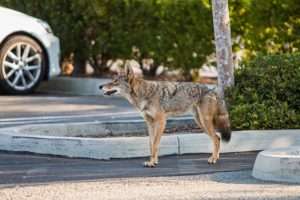 Prior to widespread agricultural and industrial development by European-Americans, coyotes largely lived west of the Mississippi. As their competitors the gray wolf (Canis lupus) and red wolf (Canis rufus) were exterminated in much of its range in the lower 48 states, coyotes were able to expand further east and north, and today they can be found in every state except Hawaii. (They’ve even been expanding toward South America in recent years!) Moreover, as coyotes are much more tolerant of humans than some larger predators such as wolves and mountain lions (Felis concolor), and are not as reliant on forested land, they were able to take advantage of land cleared for agriculture and housing. In fact, they’ve even been found in the hearts of cities as large as Los Angeles! And they respond to being hunted not by leaving an area, but by having more pups each year, meaning that more places are looking to humane, nonlethal control measures based on more recent scientific research in the field.
Prior to widespread agricultural and industrial development by European-Americans, coyotes largely lived west of the Mississippi. As their competitors the gray wolf (Canis lupus) and red wolf (Canis rufus) were exterminated in much of its range in the lower 48 states, coyotes were able to expand further east and north, and today they can be found in every state except Hawaii. (They’ve even been expanding toward South America in recent years!) Moreover, as coyotes are much more tolerant of humans than some larger predators such as wolves and mountain lions (Felis concolor), and are not as reliant on forested land, they were able to take advantage of land cleared for agriculture and housing. In fact, they’ve even been found in the hearts of cities as large as Los Angeles! And they respond to being hunted not by leaving an area, but by having more pups each year, meaning that more places are looking to humane, nonlethal control measures based on more recent scientific research in the field.
Unfortunately, these savvy animals have been followed by some unfortunate myths which can make people more concerned about coyote encounters. Let’s untangle a couple of them.
Myths About Coyotes
Many animals will become more aggressive during breeding and denning/nesting season, both to secure their territory and protect mates and young. Elk and other deer are notoriously dangerous during the fall rut, and even an antlerless doe can inflict serious damage with her sharp hooves if she feels her fawn is threatened. And of course no one wants to come between a mama bear and her cubs! Even birds are more likely to go on the attack when on the nest, whether that’s an angry Canada goose charging at you, a flock of dive-bombing crows, or even a fierce little wren yelling at you from a perch at face level.
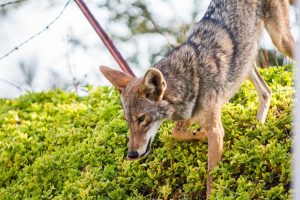 Contrary to popular belief, though, wildlife aren’t going to go out of their way to confront humans unless they feel threatened. This includes coyotes. They have a particular behavior that is often mistaken for an attack or stalking: the escort. What happens is that one coyote, usually one of the parents of a nearby litter of pups, will appear to be following you at a bit of a distance. However, they’re simply keeping an eye on you, kind of like a person watching someone of questionable character walking down the street. You’ve strayed too close to the den site, and they just want to be sure you leave without causing any trouble.
Contrary to popular belief, though, wildlife aren’t going to go out of their way to confront humans unless they feel threatened. This includes coyotes. They have a particular behavior that is often mistaken for an attack or stalking: the escort. What happens is that one coyote, usually one of the parents of a nearby litter of pups, will appear to be following you at a bit of a distance. However, they’re simply keeping an eye on you, kind of like a person watching someone of questionable character walking down the street. You’ve strayed too close to the den site, and they just want to be sure you leave without causing any trouble.
If you happen to be getting closer to the den (which you may not even be able to see) they may come closer or even growl. But unless you are actively threatening the den or pups, it is highly unlikely they’ll follow through with their bluff. Keep in mind that wildlife don’t have veterinarians they can go to, and even a seemingly minor injury can end up worsening and end in eventual death, either through infection or starvation. So a healthy coyote will only engage in conflict if they absolutely feel they have no other choice.
You may be even more likely to see an escorting coyote if you have a dog with you. This is because while humans are certainly seen as a threat, dogs are even moreso because they so closely resemble wolves. In the wild, wolves will kill coyotes over food or territory, and dogs are close enough to wolves to make coyotes more concerned. Dogs that run loose have been known to kill coyote pups, and some people even still hunt coyotes with dogs. No wonder the coyotes are concerned.
Escorting of dogs by coyotes brings up another myth: the “scout coyote”. This is a common myth that pops up especially during breeding season. Supposedly a single coyote from a pack will try to lure a dog closer, only to have the entire pack attack and kill the dog. Some people even go so far as to say it’s always a female coyote in heat trying to trap male dogs.
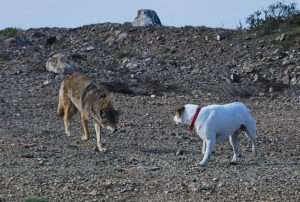
However, the coyote escort is not deliberately trying to lead the dog anywhere; it just wants the dog to go away and, like with humans, is watching it until it leaves. If the dog approaches, especially if it does so in an aggressive manner (charging, barking, chasing the retreating coyote, etc.) the pack may then leap in to defend the escort and their territory. In this case, though, it was the dog who initiated the actual aggression; all the coyotes wanted was to be left alone.
(It should be noted that dogs often escalate encounters with other wildlife like bears (Ursus spp.) and elk (Cervus canadensis) for much the same reasons. Most wildlife will continue on their way if left alone, but if your off-leash dog–even a small dog–charges in at them barking its head off, then of course the animal is going to defend itself. Most cases of “My dog protected me from a dangerous animal!” would have ended much more peacefully had the dog been under control and the wild animal been allowed to leave at its own pace.)
Keeping Coyote Encounters Safe
Most of the time when we see a coyote, we get a brief glimpse before the animal heads off in another direction; after all, we’re rather scary to them! So how can we enjoy getting to see these smart critters without anyone getting hurt–humans, pets, or coyotes?
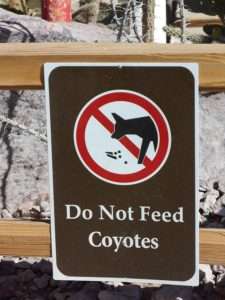 First, don’t feed the coyotes; feeding coyotes is the single biggest factor in making them aggressive toward humans. Sure, you may not deliberately putting out a dish specifically for them, but remember that these are very adaptable omnivores. Any time you leave pet food outside, or try to feed other wildlife like raccoons (Procyon lotor) or opossums (Didelphis virginiana), the coyotes are going to come in for their share. Coyotes will also help themselves to unsecured trash, and as omnivores they may even occasionally feed on fruit from orchards. And a fed coyote loses its fear of humans, which can make it more dangerous. By removing food sources around your home, you’ll keep coyotes from seeing your yard as a buffet.
First, don’t feed the coyotes; feeding coyotes is the single biggest factor in making them aggressive toward humans. Sure, you may not deliberately putting out a dish specifically for them, but remember that these are very adaptable omnivores. Any time you leave pet food outside, or try to feed other wildlife like raccoons (Procyon lotor) or opossums (Didelphis virginiana), the coyotes are going to come in for their share. Coyotes will also help themselves to unsecured trash, and as omnivores they may even occasionally feed on fruit from orchards. And a fed coyote loses its fear of humans, which can make it more dangerous. By removing food sources around your home, you’ll keep coyotes from seeing your yard as a buffet.
If you don’t want your cat eaten by a coyote, keep it inside. Yes, even cats that have spent years outdoors can be trained to be indoor kitties; if they’re still scratching to be let out weeks later, you need to give them more enrichment, and not give in to their demands. Not only will your cat live a longer life, and be less likely to be injured or killed by cars, poisons, or dogs, but it will also be safe from coyotes (and the local birds and other wildlife will be safe from your cat.) If you want your cat to still have some outdoor time, consider building a catio, or leash-training your cat! Speaking of leashes, dogs should always be on leashes. Even if they’re too big to be considered a coyote snack, remember what I said earlier about dogs tending to escalate things with wildlife, to include coyote encounters.
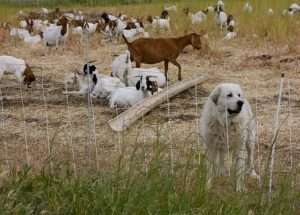
If you own chickens or other livestock, a good fence is the best protection against coyotes. A wire fence that they can’t climb through works well, especially if it has roll bars on the top (which also help keep other predators like bobcats (Lynx rufus) and bears out, too.) Keep animals in a secure coop or stable at night. For free-ranging or large pasture animals like sheep or cattle, consider a livestock guardian dog whose sole job is to take care of the herd or flock.
Use nonlethal methods whenever possible; killing coyotes often leads to increased predation. Why? Remember that when coyotes are killed, the remaining coyotes will have more pups. This means more demand for food, which means more predation on livestock. Moreover, traps and hunting often target younger coyotes that are more likely to hunt rodents (keeping them in control) rather than livestock. The vacuum created by the loss of these non-predatory coyotes may be filled by individuals from surrounding areas that are perfectly happy to hunt the livestock.
Finally, if you do see a coyote, don’t try to get closer to it, and definitely don’t try to feed it! If the coyote is at a distance, and is not approaching you, you can likely keep walking, just so long as you aren’t heading closer to it. If the coyote appears to be following you, keep an eye on it but don’t run; chances are you’re near a den and it’s just watching to make sure you leave without causing any trouble.
In the unlikely-but-still-possible event the coyote acts aggressively toward you beyond a growl, face it, make a LOT of noise, and try to make yourself look bigger by spreading your arms, and opening your jacket or umbrella if you have one. You can throw rocks and sticks at it, too. Don’t run, and don’t turn your back, but do back away slowly. If you have a dog keep them on a very tight leash; don’t let them approach the coyote. If the dog is small enough, you can pick it up as you back away. It’s okay to carry an air horn or pepper spray, but use the spray as a last resort, especially if it’s windy and you might have it blow back on you!
 The vast majority of coyote encounters are peaceful, and they offer us a glimpse into the lives of these fascinating beings. By respecting their wildness and their boundaries, we can coexist with them and allow them to continue filling the ecological niche they’ve inhabited for thousands of years.
The vast majority of coyote encounters are peaceful, and they offer us a glimpse into the lives of these fascinating beings. By respecting their wildness and their boundaries, we can coexist with them and allow them to continue filling the ecological niche they’ve inhabited for thousands of years.

This is an excellent and extremely informative article. We need to learn to live in peace with other species before it’s too late. Thank you for writing this and keep on spreading your valuable knowledge.
I’m glad you enjoyed it! Feel free to share it with anyone you feel may appreciate it.
Very good article. Thanks.
Glad you enjoyed it!
Thank you for this article!
You’re very welcome! Please feel free to share it with others who may be interested in it.